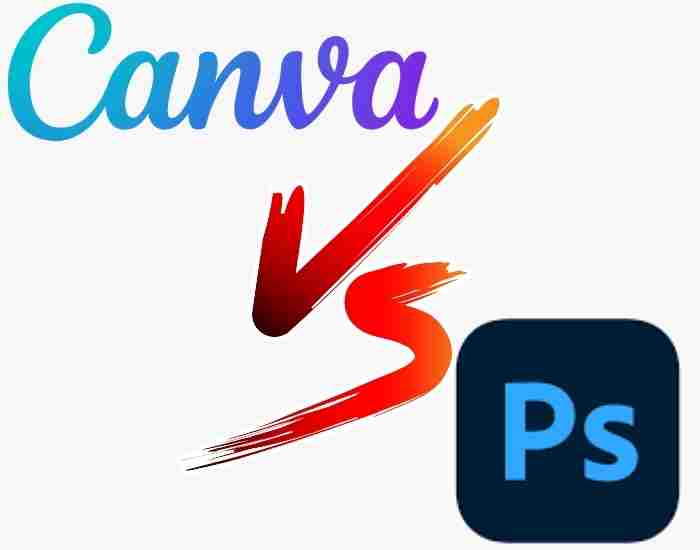In the vast landscape of digital design, two behemoths, Canva and Photoshop, have emerged as go-to choices for creators. The decision between these two tools is pivotal, impacting the outcome of your projects, whether you’re a seasoned professional or a casual enthusiast.
The digital realm offers a plethora of design possibilities, and your choice of tools can significantly influence the quality and efficiency of your creative endeavors. Canva and Photoshop cater to different needs and skill levels, making the decision-making process crucial for achieving your desired outcomes.
Navigating the Design Dilemma
As a designer, you face a crucial decision: which tool aligns with your goals, preferences, and workflow? Each platform has its strengths and unique features, making it essential to delve into a detailed exploration to make an informed choice.
Let’s embark on a journey through the intricacies of both Canva and Photoshop, examining not only their features and functionalities but also considering their usability and distinctive attributes. By the end of this exploration, you’ll be equipped with the knowledge to choose the right design tool for your specific needs and aspirations.

What is Canva?
Canva, a trailblazing cloud-based graphic design platform, has revolutionized the way people approach design. Tailored to cater to a broad spectrum of users, from beginners to seasoned professionals, Canva’s allure lies in its commitment to a user-friendly interface.
Accessibility for All
One of Canva’s standout features is its commitment to accessibility. The platform offers a variety of subscription plans, ranging from monthly options to a generous free version. This inclusivity allows both individuals and businesses to harness the power of Canva without financial constraints.
User-Friendly Interface
Navigating the design world can be intimidating, especially for those new to graphic design. Canva addresses this challenge with an intuitive and user-friendly interface. The learning curve is gentle, enabling users to swiftly grasp the basics and start creating visually stunning designs.
Versatility in Design
Canva’s appeal extends beyond simplicity; it boasts a vast library of templates, graphics, and tools. From social media graphics to business presentations, the platform offers versatile design options that cater to a myriad of creative needs.
Features and Benefits
In the dynamic landscape of graphic design, Canva stands out not just for its accessibility but for its impressive array of features and benefits that cater to a diverse user base.
Intuitive Drag-and-Drop Functionality
Canva redefines the design experience with its intuitive drag-and-drop functionality. This user-centric feature streamlines the design process, allowing creators to effortlessly bring their visions to life without the need for extensive training. Whether you’re a seasoned designer or a novice, this approach empowers you to create captivating visuals with ease.
An Extensive Library of Templates
The heart of Canva’s appeal lies in its extensive library of templates. Covering a wide spectrum of design needs, from social media graphics to business presentations and posters, the platform provides a treasure trove of pre-designed elements. This not only saves time but also serves as a wellspring of inspiration, especially for those embarking on creative projects.
Collaboration Features for Seamless Teamwork
In a world where collaboration is key, Canva steps up to the plate with robust collaboration features. Tailored for both team projects and remote work scenarios, the platform enables real-time collaboration. Multiple team members can contribute to a project, providing a seamless and efficient workflow that enhances productivity and creativity.
Tailored Templates for Social Media Platforms
For those navigating the ever-evolving realm of social media, Canva offers a tailored solution. The platform provides an extensive collection of templates specifically designed for various social media platforms. This strategic approach ensures that your social media presence remains visually cohesive and engaging across different channels.
Quick and Easy Social Media Graphics Creation
Navigating the nuances of social media graphics can be a daunting task, especially for those new to the design landscape. Canva addresses this challenge head-on by providing a user-friendly environment that allows for quick and easy social media graphics creation. The learning curve is gentle, ensuring that creators can produce visually striking content without the need for extensive design skills.
- More Post: 7 principles of design in art, with examples
What is Photoshop?
Adobe Photoshop, a true stalwart in the design industry, stands as a testament to the evolution of digital creativity. Revered for its longevity and innovative spirit, Photoshop has etched its name as an indispensable tool for designers, photographers, and digital artists alike.
Powerful and Professional-Grade Features
At the core of Adobe Photoshop’s allure is its arsenal of powerful and professional-grade features. These features go beyond the realm of standard design tools, providing users with a toolkit capable of producing intricately detailed and visually stunning creations. For professionals seeking unparalleled precision and control, Photoshop remains the go-to choice.
A Comprehensive Suite for Creativity
More than just a graphic design tool, Photoshop is a comprehensive suite that encompasses graphic design, photo editing, and digital art creation. This all-encompassing nature makes it a versatile companion for a myriad of creative projects. Whether you’re retouching photos, creating intricate digital illustrations, or designing visually compelling graphics, Photoshop offers the tools to bring your visions to life.
Unmatched customization and flexibility
What sets Photoshop apart is its unmatched level of customization and flexibility. The platform empowers users to delve into the minutiae of design with a robust layering system, advanced image editing tools, and a plethora of customization options. For designers who demand absolute control over every element of their creations, Photoshop remains the ultimate choice.
Features and Benefits
In the realm of digital design, Adobe Photoshop stands as a beacon of excellence, offering an array of features and benefits that cater to the discerning needs of professionals and enthusiasts alike.
Advanced Image Editing Tools
At the heart of Photoshop’s prowess is its arsenal of advanced image editing tools. Tailored for pixel-perfect designs, these tools allow users to manipulate and refine images with unparalleled precision. From color correction to intricate detailing, Photoshop’s image editing capabilities set the standard for the industry.
Robust Layering System
For those venturing into intricate and complex design projects, Photoshop presents a robust layering system. This foundational feature provides a dynamic and organized structure for designs. Each layer serves as a canvas for specific elements, allowing for meticulous control and seamless integration of various design components.
Extensive customization options and flexibility
What sets Photoshop apart is its commitment to providing extensive customization options and flexibility. Professional designers revel in the platform’s ability to adapt to their creative vision. From adjusting brush sizes to fine-tuning layer effects, Photoshop offers a level of customization that empowers designers to bring their ideas to life with unparalleled precision.
Photoshop for Professionals
Photoshop has transcended the realm of a mere software tool; it has become an industry standard widely used by graphic designers, photographers, and various other creative professionals. Its adoption across diverse sectors showcases its adaptability and reliability for professionals seeking top-tier design solutions.
In-depth tools and functionalities
For professionals seeking to fine-tune every aspect of their designs, Photoshop provides an exhaustive suite of tools and functionalities. Whether it’s advanced retouching, intricate detailing, or complex compositions, Photoshop offers a nuanced approach to design. This depth of features caters to the exacting standards of creative professionals, who demand nothing but the best.
Comparison: Canva vs. Photoshop
Canva’s Simplicity vs. Photoshop’s Steeper Learning Curve Canva takes pride in its intuitive design, providing users with a platform that champions simplicity. The user-friendly interface, coupled with straightforward drag-and-drop functionality, ensures that even beginners can swiftly navigate and create stunning designs. On the flip side, Photoshop boasts a more robust and intricate interface, catering to professionals who require a deeper level of control. However, this complexity comes at the cost of a steeper learning curve, making it less accessible for those new to the design world.
In the realm of user-friendliness, Canva’s approach is a smart solution for those seeking a quick and hassle-free design experience. It caters to a broad audience, including beginners and small project creators, providing a clear advantage in terms of ease of use.
Canva’s Quick and Easy Designs vs. Photoshop’s Intricate and Detailed Editing Options
Canva positions itself as the go-to platform for those seeking quick and visually appealing designs. With a vast library of templates and a simplified design process, Canva is perfect for creating eye-catching social media graphics, blog post images, and other simple projects with minimal effort.
Contrastingly, Photoshop stands as the ultimate choice for designers who require intricate and detailed editing options. The software’s advanced tools, layering system, and comprehensive customization options make it a powerhouse for professionals aiming to produce top-tier designs. While it may be more time-consuming to master, Photoshop’s capabilities are unmatched when it comes to delivering advanced visuals and amazing designs.
- More Post: What Are the Different Types of Paper and Their Uses?
- More Post: What are the best paint-pouring techniques and ideas?
Canva’s Extensive Template Library vs. Photoshop’s Need for Custom Creation
Canva distinguishes itself through a vast and diverse template library, providing users with a rich array of pre-designed elements. This expansive collection caters to various design needs, from social media posts to business presentations. The simplicity of selecting a template and customizing it to fit your vision makes Canva an ideal choice for those who value efficiency and convenience.
Contrastingly, Photoshop leans towards a more customized approach. While it offers templates, its strength lies in empowering users to create designs from scratch or modify existing templates extensively. This approach grants designers unparalleled creative freedom but requires a higher level of proficiency and time investment.
Canva’s Built-In Stock Photo Access vs. Photoshop’s External Stock Photo Subscriptions
Canva streamlines the design process by integrating a built-in stock photo library directly into its platform. Users can access a plethora of high-quality images without leaving the design interface. This not only enhances workflow but also eliminates the need for external subscriptions or additional costs.
In contrast, Photoshop relies on external stock photo subscriptions. While this approach provides access to a broader range of images, it requires users to manage multiple platforms, potentially slowing down the creative process. The choice here depends on whether convenience or access to a wider variety of stock photos takes precedence in your design workflow.
Canva’s Collaborative Features vs. Photoshop’s More Individual-Oriented Approach
In an era of collaborative work, Canva takes the lead with features designed for seamless teamwork. Its cloud-based nature allows multiple users to collaborate on a project in real-time, fostering a dynamic and efficient collaborative environment. This proves invaluable for teams working on projects or individuals seeking feedback and input.
On the other hand, Photoshop traditionally caters to a more individual-oriented approach. While cloud-based features have been introduced, the core of Photoshop’s design philosophy revolves around the control and autonomy of the individual designer. This makes it a preferred choice for solo artists or professionals who prefer a more focused and independent workflow.
Canva’s Affordable Monthly Plans vs. Photoshop’s Higher Subscription Costs
Canva positions itself as an accessible and budget-friendly option with a range of affordable monthly plans. Its free version, coupled with reasonably priced subscription plans, makes it an attractive choice for individuals, small businesses, and those looking for a cost-effective design solution.
Conversely, Photoshop tends to have higher subscription costs. This investment reflects the depth and professional-grade features it offers. While Photoshop remains the industry standard for advanced design projects, the higher pricing may be a consideration for individuals or small businesses operating on a tight budget.
FAQs
Can I use Canva for professional design work?
Absolutely. Canva has evolved beyond its origins as a beginner-friendly tool and has become a versatile platform suitable for professional design work. Its intuitive interface, extensive template library, and collaborative features make it a valuable asset for both individual designers and teams. For small to medium-sized projects, Canva’s efficiency and user-friendly nature make it an excellent choice. However, for highly complex or specialized projects, particularly those requiring intricate details and advanced customization, professionals might still lean towards the comprehensive features offered by more advanced tools like Photoshop.
Is Photoshop worth the investment for a beginner?
It depends on your goals and commitment. Photoshop is a powerful tool with a steep learning curve. While beginners may find the initial stages challenging, the investment in learning Photoshop can be rewarding for those serious about graphic design. The software’s capabilities go beyond basic design, offering advanced features for photo editing, digital art creation, and intricate designs. For beginners seeking a professional-grade tool with a long-term perspective, the learning curve is a worthwhile investment. However, for those focused on quick and straightforward design needs, more user-friendly tools like Canva might be a preferable starting point.
Can Canva replace Photoshop for photo editing?
Yes, to a certain extent. Canva provides a range of photo editing features suitable for basic to intermediate-level requirements. It’s an excellent choice for quick edits, adding filters, or enhancing images for social media. However, for professionals or enthusiasts requiring advanced photo editing capabilities, Photoshop remains unparalleled. Photoshop’s advanced tools, layering system, and precise controls offer a level of detail and refinement that might be indispensable for complex photo-editing projects. Canva serves well for quick and easy edits, but Photoshop’s depth is unmatched for those seeking top-tier photo editing.
Are there limitations to Canva’s free version?
Certainly, while Canva’s free version offers an impressive array of features, it comes with certain limitations. The free plan provides access to a substantial number of templates, graphics, and design elements. However, to unlock the full potential of Canva, users often find it beneficial to upgrade to a paid subscription. Some limitations of the free version include a more restricted selection of premium templates, limited access to advanced features, and the presence of the Canva watermark on designs. For casual users and small projects, the free version is a fantastic starting point, but those with more demanding design needs may find the premium plans better suited to their requirements.
Which tool is most widely used in the design industry?
The industry’s choice between Canva and Photoshop often depends on the nature of projects and the level of professionalism required. Canva has gained widespread popularity for its user-friendly interface, accessibility, and collaborative features, making it a go-to tool for quick and visually appealing designs, particularly in social media and marketing. On the other hand, Photoshop remains an industry standard, especially among professional designers, photographers, and creative agencies. Its advanced capabilities and versatility make it an indispensable tool for projects demanding intricate details and top-tier design quality. While Canva has democratized design, Photoshop’s legacy and depth continue to make it the preferred choice for many seasoned professionals.
- More Post: What is the Difference Between Art and Craft?
- More Post: How Much Does a Printer Cost?
Conclusion
Choosing between Canva and Photoshop is a decision that hinges on your specific design needs, your level of expertise, and the outcomes you aim to achieve.
Canva stands out for its user-friendly approach, collaborative features, and quick design capabilities, making it an ideal choice for those with limited design experience or time constraints.
On the other hand, Photoshop offers unparalleled depth and advanced features, making it the clear choice for professionals who demand intricate details, customization, and top-tier design quality.
Consider factors such as your project requirements, preferred design process, skill level, and budget before making the final decision. Both Canva and Photoshop have distinct strengths, and the winner in this comparison ultimately depends on what you’re looking to achieve in your design projects.






